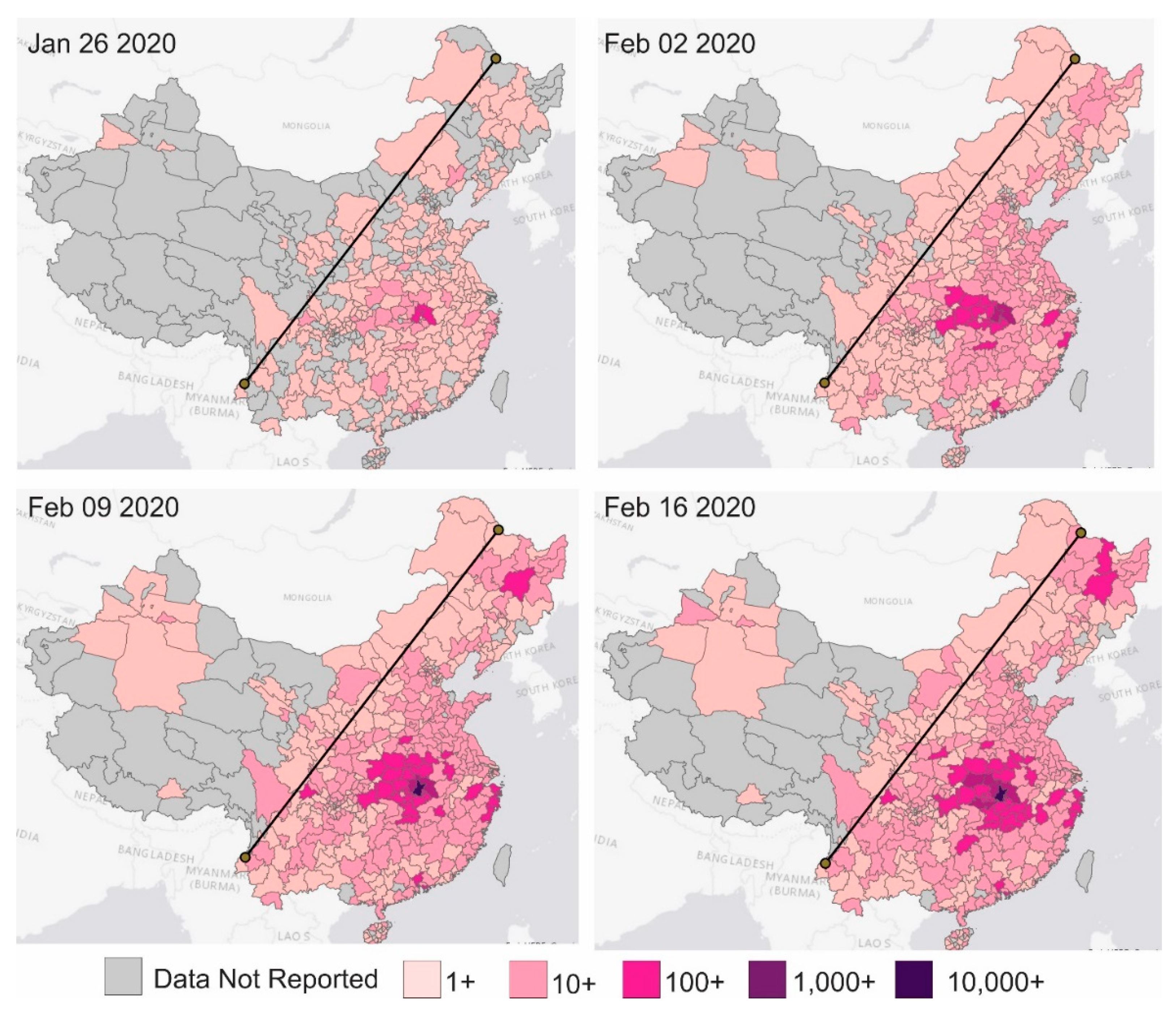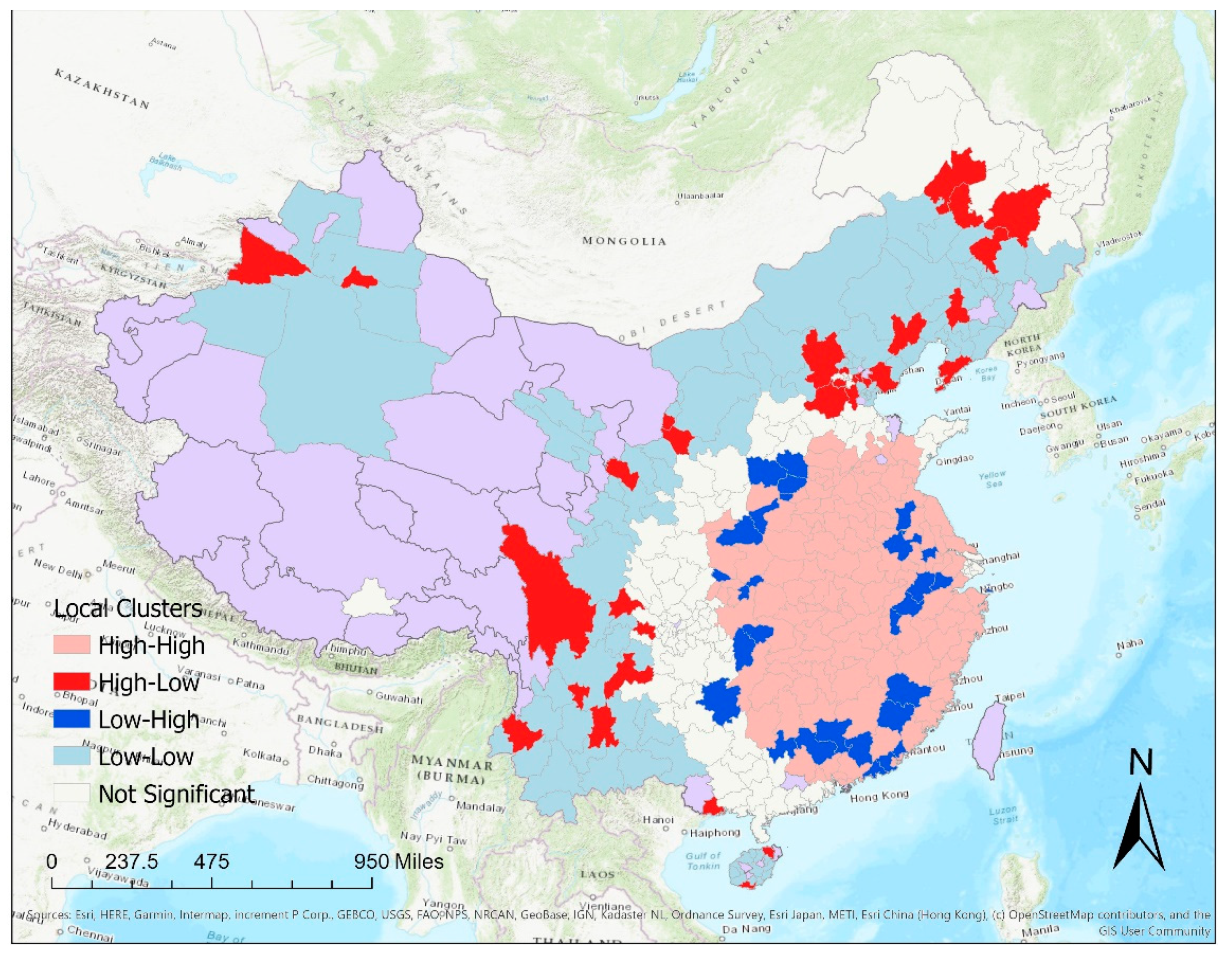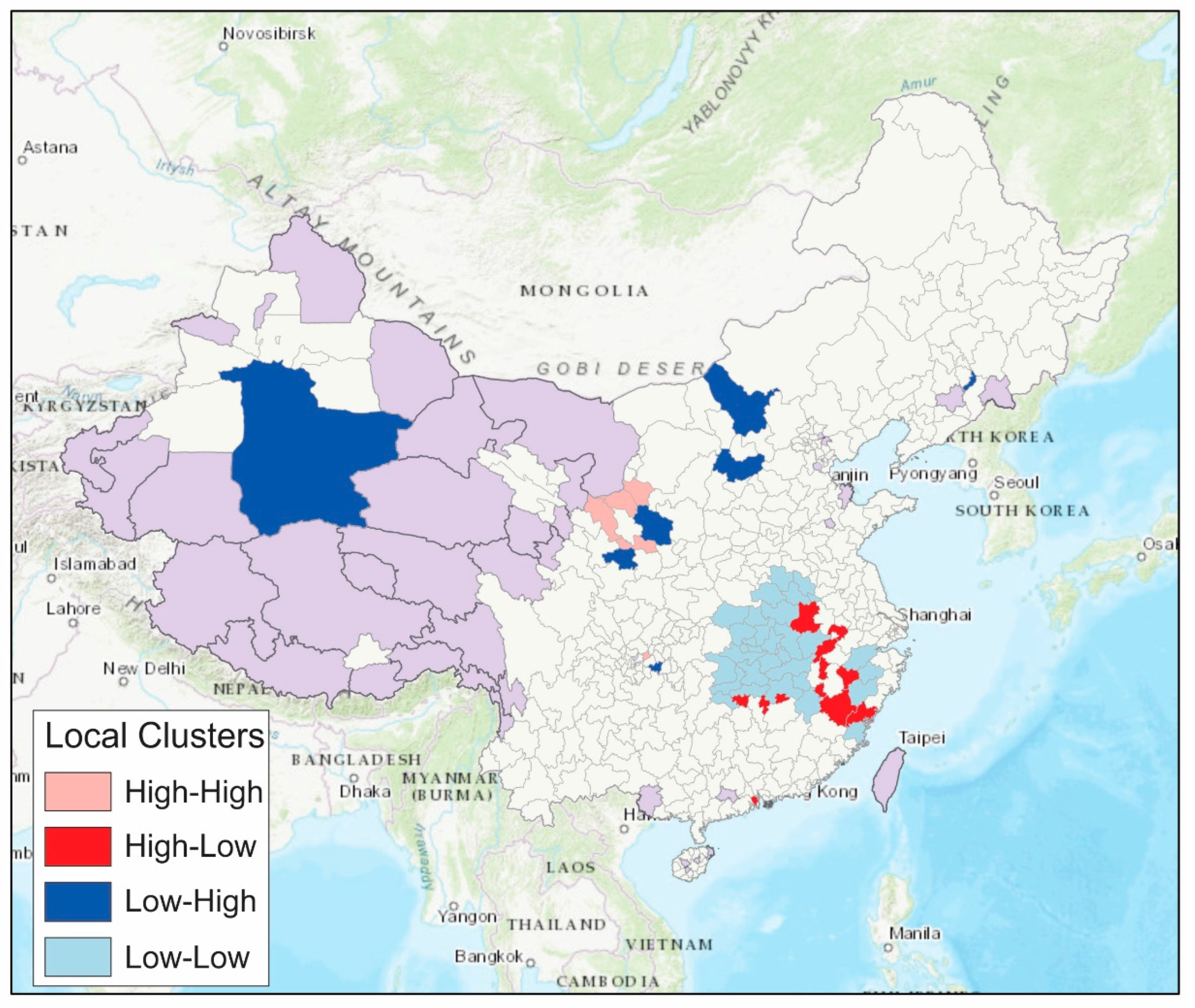Appendix A.5. Footnotes to Table 1
1 A reporting unit in this study is defined from the perspective of epidemiological surveillance. A reporting unit is a sub-provincial unit that reports COVID-19 data to the provincial health commissions and their data are shown distinctly in a provincial health commission press release. In a province, such sub-provincial report units are usually prefecture-level cities (地級市), prefectures (州), autonomous prefecture (自治州) of ethnic minorities, or leagues (盟) in Inner Mongolia. In the four centrally administered municipalities, they are (urban) districts (區/区) and (rural) counties (縣/县).
2 For the centrally administered municipalities of Beijing, Shanghai, and Tianjin, the municipal government categorized non-natives to their cities as a distinct category (see
Table 2). These categories were present in the DXY data set but were not included in our analysis. They were also not included in the column, “DXY data entries (excl. duplicate row)”, because these categories were not categories created by (sub-provincial) location.
3 These jurisdictions are not in the original DXY data set as they did not report any COVID-19 cases. They were added to the dataset for statistical analysis.
4 In Anhui Province, Susong County (宿松) is part of Anqing City (安庆市).
5 In the municipality of Beijing, Pinggu District (平谷区) did not have any cases throughout the study period.
6 In the municipality of Chongqing, two urban districts did not have any cases throughout the study period. The three “new areas” are Chongqing Liangjiang New Area (两江新区), Gaoxin (高新), and Wansheng (万盛经开).
7 In Gansu Province, three prefecture-level cities, Jiayuguan (嘉峪关市), Wuwei (武威市), Jiuquan (酒泉市) in Gansu did not report cases during the study period.
8 In Guangdong Province, Yunfu City (云浮市, a prefecture-level city) did not report cases during the study period.
9 In Guangxi Zhuang Autonomous Region, Chongzuo City (崇左市, a prefecture-level city) did not report cases during the study period.
10 In Hainan Province, Sansha City (三沙市, a prefecture-level city), Wuzhishan City (五指山市, a county-level city), Tunchang County (屯昌县), and Baisha Li autonomous county (白沙黎族自治县) did not report cases during the study period.
11 In Heilongjiang, Harbin is a sub-provincial city. It is counted as one of the 12 PLCs here.
12 Five subdivisions in Henan Province reported cases separately for several days. They were merged with prefecture data. Gongyi (巩义) is part of Zhengzhou City (郑州市). Hua County (滑) is part of Anyang City (安阳市). Dengzhou (邓州) is part of Nanyang City (南阳市). Yongcheng (永城) is part of Shangqiu City (商丘市). Gushi (固始) is part of Xinyang City (信阳市).
13 In Inner Mongolia Autonomous Region, Alxa League (阿拉善盟) did not report cases during the study period.
14 For Jiangxi Province, we merged the one case in Ganjiang New District (赣江新区) into Nanchang City (南昌市) for both mapping and statistical analysis, as that case was originally part of the cumulative number in Nanchang, that has been listed separately since the press release of Feb 10 on data of Feb 9.
15 In Jilin Province, Baishan City (白山市) did not report any cases in the study period. The two sub-prefectural-level cities that reported cases are Gongzhuling (公主岭) and Meihekuo (梅河口). They are technically parts of the prefecture-level cities of Siping and Tonghua respectively, but they reported cases under separate lines. These two sub-prefectural-level cities were excluded from the statistical analysis.
16 In Liaoning Province, the city of Fushun (抚顺市) did not report cases during the study period.
17 Technically, Ningxia Hui Autonomous Region was divided de jure into five prefecture-level cities. However, Ningdong Energy Chemical Industry Base (宁东能源化工基地) was administered under a special arrangement and the confirmed case in the township of Ningdong (宁东镇) in that Industry Base was reported under a separate line on the press release of Jan 30. The Ningdong Energy Chemical Industry Base is excluded from statistical analysis.
18 In Qinghai Province, only Xining City (西宁市) and Haibei Tibetan Autonomous Prefecture (海北藏族自治州) reported cases during the study period. The rest of Qinghai did not report any cases.
19 In Shaanxi Province, the city of Hancheng (韩城市) is a sub-prefectural county-level city that is de jure part of Weinan City but its one case was listed separately. Yangling Agriculture Hi-Tech Industrial Zone (杨凌农业高新技术产业示范区) is de jure part of Xianyang, but it is directly administered by the province; its one case was listed separately. Both Hancheng and Yangling were excluded from the statistical analysis.
20 In Shandong Province, the city of Dongying (东营市) did not report any cases in the study period.
21 In the municipality of Tianjin, Jinghai District (静海区) and Jizhou District (蓟州区) did not report any cases during the study period.
22 In Tibet Autonomous Region, only the city of Lhasa (拉萨市) reported one imported case from Wuhan on 29 January 2020. The other six reporting units reported zero cases.
23 In Xinjiang Uighur Autonomous Region, alongside the regular sub-provincial administrative units, there are settlements ran by the Xinjiang Production and Construction Corps (XPCC, 新疆生产建设兵团) [
18]. Such settlements had their own organizations distinct from the rest of Xinjiang. The XPCC administration has a unique political status in China. For example, in the daily press release made by the National Health Commission on the daily case count of COVID-19, it begins as follows: “[Date] 0–24 h, 31 provinces (autonomous regions, centrally administered municipalities) and the Xinjiang Production and Construction Corps reported [number] new confirmed cases, ….” The XPCC is listed alongside the provinces. We are unable to map the XPCC settlements and only seven cities, prefectures, and autonomous prefectures were mapped even though we kept the 13 rows of data. In Xinjiang, two cities (Ürümqi 乌鲁木齐市and Turpan 吐鲁番市), two prefectures (Aksu 阿克苏地区and Tacheng 塔城地区), three autonomous prefectures (Changji 昌吉回族自治州, Bayingolin 巴音郭楞蒙古自治州and Ili 伊犁哈萨克自治州) reported cases; the other seven did not. Six of the 14 XPCC divisions (i.e., 4th, 6th, 7th, 8th, 9th, and 12th) reported cases, but they were not mapped in this paper.
24 In Yunnan Province, Nujiang Lisu Autonomous Prefecture (怒江傈僳族自治州) and Diqing Tibetan Autonomous Prefecture (迪庆藏族自治州) did not report any cases during the study period.














